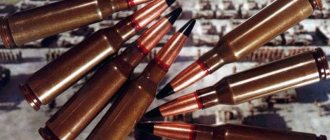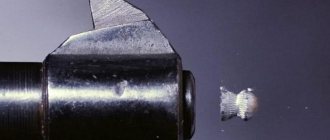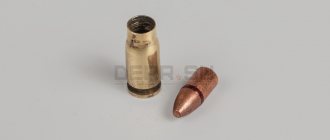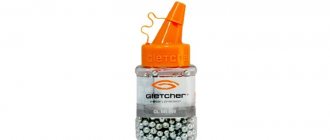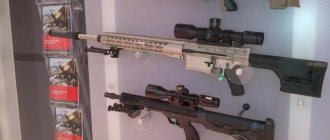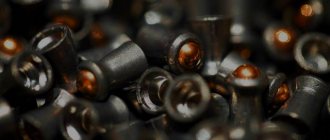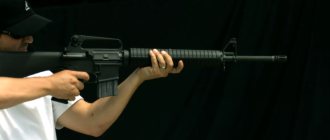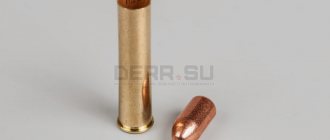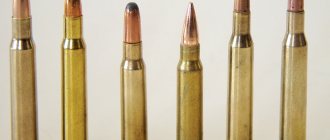Bullet Sovestre is now in Russia
What is the maximum distance at which a 12 gauge can compete with a rifled barrel? The answer to this question directly depends on the characteristics of the ammunition used.
Even 15-20 years ago, our hunters were simply forced to independently manufacture bullets of various designs, since industrially produced bullets did not provide acceptable accuracy at distances over 20 meters.
The situation was radically changed by Viktor Polev, who designed an arrow-shaped bullet with a polyethylene shank that acts as a wad-obturator and a detachable composite container. The Poleva bullet was followed by the Poleva-2 and the expansive Poleva-3. All of them, when properly loaded, provide good accuracy comparable to (or better than) most good foreign bullets, especially at distances over 75 m.
What about foreigners? Upon closer examination, it turns out that until recently only a few types of bullets for smoothbore ammunition were the most popular in Europe - these are Brenneke, Foster, Gualandi, and Mac Elvin bullets. All of the mentioned bullets at a distance of 50 meters show an R100 accuracy of 25–40 mm. That is, all the bullets in a series of three to five shots fall into a circle with a diameter of 5–8 cm. Of course, there are other bullets, sometimes superior to their rivals in various individual indicators, but they have not really become widespread. The only exception is the French bullet, designed by former military engineer Jean-Claude Sauvestre (JC Sauvestre) and named after its creator.
The Sovestra bullet was the only one that was able to earn recognition among conservative European hunters, having proven over seven years its high efficiency and real superiority over existing bullets.
Until 2000, cartridges equipped with Sovestre bullets entered Russia by accident and were not properly certified and allowed for circulation. The first, in all respects legal, delivery to the territory of the Russian Federation was carried out at the beginning of 2000 by the St. Petersburg arms showroom "Arsenal" with the assistance of the French company Europ Arm. Moreover, Arsenal specialists decided to start promoting the bullet with 12x76 Magnum cartridges. In general, the Sovestra bullet is produced in 12, 16 and 20 calibers and is chambered in 12x76, 12x70, 16x70, 20x76, 20x70 caliber cartridges.
The most powerful 12x76 Magnum cartridge has impressive characteristics: with a bullet mass of 26 g (31 g with container), its initial speed is 580 m/s, and the muzzle energy is 4380 J. The actual initial speed in this case is of secondary importance - significantly What’s more important is the bullet’s ability to retain energy along the trajectory and completely transfer it to the target object (in our case, the animal) upon impact.
It should be noted right away that a cartridge with a Sovestre bullet is not a cheap pleasure, which can be afforded mainly by owners of expensive weapons. But how do you evaluate a successful hunt? It probably doesn’t always make sense to divide kilograms of meat and horn shoots into banknotes. However, so far only the 12x76 Magnum cartridge is on sale, which assumes the presence of a 12-gauge shotgun with a 76-mm chamber, and these are mainly imported samples.
So what is the Sauvestre bullet?
This is an arrow-shaped lead alloy bullet with a plastic tail and a composite container that functions as a wad-obturator. To ensure that it is impossible to dismantle the bullet in flight, the tail is connected to the bullet itself (jacket) with a metal core, which also serves as a striking element when the bullet is destroyed in the body of the animal. The design of the bullet ensures fragmentation of the lead jacket into large fragments weighing 4–6 g, which have high kinetic energy. At the same time, experiments and practical experience show that the nature of the damage is directed and local. With a guaranteed mortal wound, there is no unnecessary spoilage of meat.
| Schematic section of a Sovestre bullet. 1 – lead jacket, 2 – steel core (threaded rod), 3 – shank with feathering, 4 – galvanic coating (chrome), 5 – recess, increasing the expansive action of the bullet, 6 – bevels on the tail, giving the bullet a rotational movement along the trajectory |
In addition to special design measures aimed at increasing the lethality, the Sovestra bullet has a unique ability to maintain speed (and, accordingly, energy) at long distances, up to 100 m. In addition, the Sovestra bullet has a much flatter trajectory than its analogues. And the probability of a hit in real conditions greatly depends on this characteristic. To put it simply, we can say that the flatter the trajectory, the less the shooter’s error in determining the range to the target affects the probability of a bullet hitting. Agree that in rapidly changing hunting conditions it is not difficult to make a mistake at 15–20 m, and for other bullets at distances over 50 m the difference in height between the impact points at 50 and 75 m is up to 30 cm - it is not difficult to “miss”. The difference between the impact points of a Sovestre bullet at distances of 50 and 75 m is only 6 cm - if you want, you won’t miss! And the drop in trajectory at a distance of 100 m from the zero line is only 18 cm - an excellent result for a smooth barrel.
| Cartridge with a Sovestre bullet of original equipment (France), a bullet in a container, the bullet itself and parts of the container |
During the editorial tests, another advantage of the Sovestra bullet was revealed, related to the flatness of the trajectory. The shooting was carried out from a Benelli Praktika self-loading shotgun with a standard mechanical (diopter) sighting device. In addition to the cartridges with the Sovestre bullet of the original equipment, they also fired “Sport-Active” cartridges with the Gualandi bullet. Both bullets in a closed shooting range at a distance of 50 m showed comparable accuracy, but the average point of impact (MPO) of the Gualandi bullet was 25 cm lower. This can lead to the fact that on some types of weapons the range of vertical adjustments of the mechanical sight is simply not enough to bring the weapon to normal combat at long distances. True, this drawback is easily eliminated by installing an optical (collimator) sight.
According to the manufacturer, at a distance of 100 m, all hits of a series of 5 shots with a Sovestre bullet fall into a circle with a diameter of 25 cm. It is quite enough for hunting large animals, although it does not reach the performance of rifled barrels. But what is much more important is that at this distance the bullet has a speed exceeding the speed of sound (V100 = 430 m/s) and significant kinetic energy (E100 = 2,450 J), which allows us to consider the bullet suitable not only for hitting animals at long distances , but also to ensure his defeat.
| Sovestre bullet speeds at various distances (m/s) | |||||
| Cartridge | V0 | V25 | V50 | V75 | V100 |
| 12x70 | 500 | 467 | 437 | 407 | 377 |
| 12x76 "Magnum" | 580 | 535 | 497 | 464 | 434 |
| Energy of Sovestpa bullets at various distances (J) | |||||
| Cartridge | E0 | E25 | E50 | E75 | E100 |
| 12x70 | 3250 | 2840 | 2490 | 2160 | 1850 |
| 12x76 "Magnum" | 4380 | 3720 | 3220 | 2800 | 2450 |
| Thanks to the perfect aerodynamic shape, Sovester bullets at a distance of 100 m lose only 25% of the initial speed, which is an outstanding result for a smooth-bore weapon. At a distance of 100 m, the energy of Magnum cartridge bullets is 30% greater than the energy of a 12x70 cartridge bullet | |||||
| Blue color – cartridge 12x76, red – 12x70. At a distance of 100 m, the drop in trajectory for the 12x76 cartridge is only 18 cm - an excellent result for a smooth barrel. It is recommended to zero the weapon (combine the aiming point (AP) and the midpoint of impact (SIP)) at a distance of 107 m (for the 12x76 cartridge) and 96 m for the 12x70 cartridge. With correct zeroing, all bullets in the distance range from 0 m to 107 m will “land” no higher than 20 cm above the aiming point. This allows you to shoot at an animal with a constant sight and be sure that the bullet will hit the area of vital organs (of course, if you are aiming there) |
| The left target shows the results of firing a Sovestra bullet from a classic smoothbore gun with an optical sight (data from the bullet manufacturer). On the right are the results of editorial shooting from a Benelli Praktika self-loading shotgun using a standard mechanical sight (diopter). The sighting devices were not adjusted, which explains the shift of the group of hits to the left of the center of the target. In both cases, shooting was carried out in a closed shooting range at a distance of 50 m |
Evgeniy Alexandrov
Sauvestre bullet - precision ammunition for a smooth bore
Among the variety of bullets for smooth-bore weapons, the Sauvestre, or Sovestre, bullet stands apart completely. And the point is not only and not so much in its appearance, although most of all it resembles a small feathered projectile for a modern tank gun. It is reminiscent, by the way, not by chance, but we will talk about this a little later. The point is its unique ballistic characteristics. Yes, there are different types of bullets with which experienced shooters collect very impressive piles at 60 and even 80 m. But today only Sovestra allows an ordinary hunter with a smoothbore gun to confidently hit a target at distances of 80-100 m, not at the shooting range, but in practice hunting. What's the secret?
Let's start with history. Quite recently, by historical standards, there lived in France a military engineer, Jean-Claude Sauvestre. The main focus of his engineering activity was the creation and improvement of... yes, you guessed it - finned sub-caliber ammunition for modern tank guns, which - coincidence - are also smooth-bore. But another coincidence is no less important to us: France is almost the only country in Europe where the use of rifled weapons in driven hunts is legally limited. And so it happened - engineering talent, subject matter, interest in hunting and simply a vital need to improve the accuracy and firing range of bullets from smoothbore guns.
Despite the apparent simplicity of the task (well, what does it cost for an engineer developing real high-precision ammunition for large smoothbore guns to make a small copy of such ammunition for a gun?!), Jean Claude spent almost 10 years developing his bullet. A new bullet appeared on the shelves of French gun stores in 1993, and although conservative French hunters greeted it rather warily, within just a few hunting seasons the Sauvestre bullet gained wild popularity, significantly ousting such generally recognized giants as Brenneke and Blondeau from the shelves. Still would! It turned out that at distances of 60 meters or more it is slightly inferior to its rifled counterparts.
What are the main difficulties in shooting accurately from a smooth barrel? The first is low accuracy. There are several reasons - deformation of the bullet in the barrel due to high pressure and acceleration, high drag, poor stabilization along the trajectory. But for shooting beyond 50m, this is not even the main thing. The main difficulty lies elsewhere - the low initial velocity of the bullet and the large drop in trajectory with distance. At a shooting range, you can zero a gun, say, at 50 m and determine the drop in trajectory at 60, 70 and 80 m. But on a hunt, when shooting further than 50 m, an error in estimating a distance of 15-20 m will lead to misses or wounded wounds. And today only Sovestre bullets have 100 m - this is the direct shot distance. When zeroing a weapon at this distance, the maximum excess of the bullet trajectory above the aiming line will be only 8 cm.
The secret of this significant fact lies, of course, in the design of the bullet. It consists of 4 parts: a steel core, the actual bullet body, which is made in two versions - lead and brass, a stabilizer shank and a special seal container. Like sub-caliber finned tank shells, the shank of the Sovestre bullet rests on the bottom wad of the cartridge case directly in the gunpowder. When fired, the bullet is accelerated by a seal container made of a special (this is the know-how of Monsieur Jean Claude) very hard plastic, which tightly covers the bullet along almost the entire length, preventing its deformation in the barrel. The steel core connects the bullet body and the stabilizer shank, and also provides the bullet with excellent penetration ability coupled with expansion sufficient for hunting any largest animal. And the main feature of the bullet design is the ability to accelerate it to almost rifled speeds and - due to low drag - maintain these speeds at distances that are very large by smoothbore standards.
Currently, several varieties of Sovestra bullets are produced for 12-, 16- and 20-gauge. The ballistic performance of the 12 gauge mini-magnum and magnum lead bullets is especially impressive. With a weight of 22 and 26 grams, the initial speed of these bullets is 565 and 580 m/sec. respectively. It is clear that such cartridges use not quite ordinary gunpowder, so do not be surprised that the gunpowder in the Sauvestre case is poured freely, as in a rifled cartridge. But back to speed: at a distance of 100 m, the mini-magnum bullet retains another 394 m/sec. and energy 1744 J, and a magnum bullet - 423 m/sec. and 2324J, This is enough to reliably kill large wild boar, deer, and elk.
Will accuracy be enough for this destruction? More than. The accuracy of all Sovestre ammunition, without exception, declared by the designer is 25 cm per 100 m. However, here Jean Claude was clearly being modest - the potential of his bullet is an order of magnitude higher. In the vastness of the RuNet there are independent reports on shootings, where, for example, at a distance of 62 m, 5 bullets were placed in a circle of 8 cm. However, this, of course, is far from the rifled indicators, but we remember: for hunting, the main thing is that the bullet on this maintains high speed and energy over distances, and even the stated accuracy is sufficient for hunting purposes. Moreover, the flatness of the trajectory allows you to shoot up to 100 m simply “along the bar”, without any adjustments in height. You just need to consider the following points.
Throwing angle. Quite often it happens that the STP when shooting with Sovestra bullets is greatly shifted relative to the STP when shooting with conventional bullets. This occurs due to the higher speed of the bullet passing through the barrel and a different amplitude of the latter’s vibrations. Conclusion - the Sovestre bullet certainly requires zeroing and individual adjustment of sighting devices.
Choke constrictions. The manufacturer states that the Sovestre bullet can be used with any choke, up to full choke. As is most often the case, barrels usually show better accuracy not with a cylinder, but with a small choke. With which? This, again, can only be determined by shooting a specific barrel. But there is a recommendation not to use reductions greater than 0.5 at temperatures below -15 degrees Celsius. The fact is that in the cold, in a tight muzzle constriction, when fired, there were cases of cracking of the hard plastic of the container, which led to a large deviation of the bullet from the trajectory.
So, does the Sovestre bullet have no flaws at all? Unfortunately, it is not. There is a significant drawback - the rather high price of the cartridge. The reason for this is quite objective - technology. High-precision casting, a large number of parts and labor-intensive assembly, the use of special and expensive plastic - all this together makes cartridges with the Sovester bullet quite a “biting” pleasure. However, depending on what you compare it with. And let me remind you, there is nothing to compare with: Sovestra today is the only bullet for smooth weapons that can be confidently used at any distances up to 100 m without any adjustments to height.
Alexey Popov Basic instinct 08-2012
Boar hunting: ammunition
Hunters who do not have a permit for rifled weapons should attach special importance to the selection of ammunition for a wild boar. We bring to their attention the thoughts and advice of experienced people.
Possible fines for a miss and a wounded person impose significant responsibility on the participants in the hunt for the accuracy of the shot. Much depends not only on the characteristics of the gun, but also on the ammunition used, mainly on the design of the bullet used. Of course, boar buckshot could solve all the problems, but the rules, for example, of driven hunts for ungulates require only a bullet cartridge.
The requirement for a bullet cartridge can be formulated according to the following points:
- Accuracy
- Sufficient stopping power
- Use in semi-automatic and double-barreled shotguns.
Almost immediately, with some exceptions, cartridges with domestically produced bullets were rejected; not only the lead components of the bullets looked too makeshift, but also the plastic stabilizers and containers, if present. And the difference in mass, and sometimes in size, did not in any way imply accurate shooting and stable hits.
Glavpatron - Cartridge Manufactory LLC offered cartridges with a 12 caliber bullet "Gualandi" (Italian) weighing 32 g (photo). Guaranteeing accuracy at 50 m of no more than 120 mm.
Perhaps the results of the zeroing should be attributed to the characteristics of a particular gun or the skill of the shooter, but the spread of bullets turned out to be somewhat large. The light bullet 28.4 gr showed itself more reassuringly. BRENNEKE (brenneke) cartridge from Rottweil, but still I would like to have higher accuracy. did not claim high accuracy of its bullets, but its “Tandem” (photo) and “Nitrogen” bullets fit within the stated 20 cm, which indicated the honesty of the manufacturer. As a backup option, I selected “Trio” cartridges, 3 lead balls (d=11.5mm) in a container (in 2 half-shells), covering a 50 m circle with a diameter of no more than 45 cm.
I really liked the dozen and a half cartridges given to me by the famous hunter-writer Sergei Losev, loaded with a bullet designed by S.T. Mitichkina. There was only one drawback: after test shooting, there were only ten rounds left, which was clearly not enough for the upcoming hunt. It is a pity that this ammunition has not yet appeared on sale.
The well-known popular “POLEVA” bullets (photo), along with the most accurate shots, suddenly gave such an inaccurate hit, which could only be explained by the low culture of production of these sub-caliber bullets. I was amazed by the technical characteristics of the cartridge with the ZENIT bullet (photo) with a fantastic ballistic coefficient of 4.7 and a dispersion diameter at a distance of 100 m of 10 cm. The only thing that upset me was that I did not come across these cartridges for sale. But the design of the arrow-shaped bullet itself gave rise to the idea of looking for similar bullet cartridges.
The search was successful. The cartridges almost completely coincided with the declared characteristics. Having minor differences in weight and characteristics, primarily, the deformation of the bullet body when hitting an animal, the vertical deflection of the bullets was within 1-4 cm at a distance of up to 100 m, essentially a direct shot. The speed and energy of the bullet was more than enough not only for a young boar, but also for larger game.
Cartridges loaded into a 76 mm case, such as “magnum” and “semi-magnum”, were superior in energy to a simple cartridge, depending on the firing distance from 30% to 70%.
So what is the Sauvestre bullet?
This is an arrow-shaped lead alloy bullet with a plastic tail and a composite container that functions as a wad-obturator. To ensure that it is impossible to dismantle the bullet in flight, the tail is connected to the bullet itself (jacket) with a metal core, which also serves as a striking element when the bullet is destroyed in the body of the animal. The design of the bullet ensures fragmentation of the lead jacket into large fragments weighing 4–6 g, which have high kinetic energy. At the same time, experiments and practical experience show that the nature of the damage is directed and local. With a guaranteed mortal wound, there is no unnecessary spoilage of meat.
Schematic section of a Sovestre bullet
- Lead shirt
- Steel core (threaded rod)
- Shank with feathering
- Electroplating (chrome)
- A recess that increases the expansive action of the bullet. Bevels on the tail that give the bullet rotation.
In addition to special design measures aimed at increasing the lethality, the Sovestra bullet has a unique ability to maintain speed (and, accordingly, energy) at long distances, up to 100 m. In addition, the Sovestra bullet has a much flatter trajectory than its analogues. And the probability of a hit in real conditions greatly depends on this characteristic. To put it simply, we can say that the flatter the trajectory, the less the shooter’s error in determining the range to the target affects the probability of a bullet hitting.
Agree that in rapidly changing hunting conditions it is not difficult to make a mistake at 15–20 m, and for other bullets at distances over 50 m the difference in height between the impact points at 50 and 75 m is up to 30 cm - it is not difficult to “miss”. The difference between the impact points of a Sovestre bullet at distances of 50 and 75 m is only 6 cm - you won’t miss the movement on the trajectory you want! And the drop in trajectory at a distance of 100 m from the zero line is only 18 cm - an excellent result for a smooth barrel.
Cartridge with a Sovestre bullet of original equipment (France), a bullet in a container, the bullet itself and parts of the container
Sovestre bullet trajectory decrease graph
Blue color – cartridge 12x76, red – 12x70. At a distance of 100 m, the drop in trajectory for the 12x76 cartridge is only 18 cm - an excellent result for a smooth barrel. It is recommended to zero the weapon (combine the aiming point (AP) and the midpoint of impact (SIP)) at a distance of 107 m (for the 12x76 cartridge) and 96 m for the 12x70 cartridge.
With correct zeroing, all bullets in the distance range from 0 m to 107 m will “land” no higher than 20 cm above the aiming point. This allows you to shoot at an animal with a constant sight and be sure that the bullet will hit the area of vital organs (of course, if you are aiming there)
